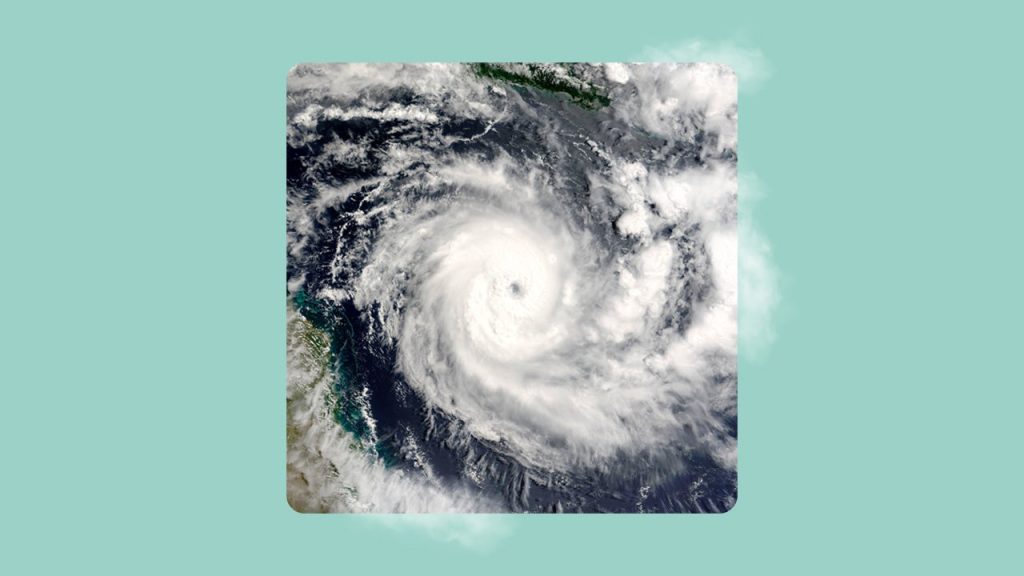It is shaping up to be a record-setting year for hurricanes. AccuWeather predicts 20 to 25 named storms throughout the 2024 hurricane season, which runs from June 1 until the end of November. If predictions are correct, this year will rank third in terms of the most named storms since 1950. While we can’t tell you how to avoid hurricanes altogether, we can offer some tips on how you can prevent hurricane damage to your home.
What types of damage do hurricanes cause to homes?
According to the National Oceanic and Atmospheric Administration (NOAA), hurricanes are some of the most expensive and deadly weather-related disasters. On average, a single hurricane results in around $22.8 billion in damage. And of the 363 billion-dollar extreme weather events since 1980, hurricanes caused over $1.3 trillion in damage and close to 7,000 deaths.
Roofs often bear the brunt of hurricane-force wind damage. Category 4 hurricanes generate winds up to 156 mph, which can rip off roofs and uproot trees. Hurricane winds and flying debris can also shatter windows and damage homes’ physical structure, allowing water to seep in and ruin personal belongings.
Storm surges are another consequence of hurricanes. They frequently result in flooding — one of the most common and destructive incidents homeowners face. In fact, a single inch of floodwater can cause $25,000 in damage to a home.
12 ways to prepare your home for hurricane season
Not all hurricane damage prevention efforts need to be expensive. Taking small steps to fortify your home can help make a big difference this hurricane season and may even result in lower home insurance costs. Below, we’ve identified strategies suitable for various budgets.
1. Board up windows with plywood before a storm is expected
Cost: Around $10–$50 per 4 feet by 8 feet sheet
One of the most popular ways to prevent hurricane damage is to use a sheet of plywood and a handful of nails. Installation is relatively easy to do yourself. Homeowners typically “board up” a day or two before the storm is forecast to strike by attaching 5/8-inch or 1/2-inch plywood to the windows of their homes. The cost of the materials will vary by location, and the total project cost will depend on the number of windows.
- Pros: Plywood can help effectively reduce the impact of damage or even prevent damage from strong winds, heavy rain, hail and flying debris. You can typically find the materials at any home improvement store. If stored properly, they can be used from season to season.
- Cons: This project can be time-consuming and may require a helping hand. Installation may involve drilling holes in siding and bricks, and boarded windows will block out sunlight.
2. Use fabric panels over windows and doors to deflect flying debris
Cost: Around $12–$17 per square foot
Polymer-based, storm-strength fabric panels add trampoline-like cushions to windows and doors and repel flying debris. Panels are anchored to the edges of windows and doorways with grommets and wing nuts or clips and pins.
- Pros: The panels can easily be installed and removed, then rolled up and stored in a compact space. Most are translucent and allow for visibility through windows.
- Cons: Professional installation may be required for best results.
3. Anchor your roof with hurricane straps
Cost: $1,000+ for professional installation
Most homes are built to hold the roof up, not down. To account for the upward and lateral lifting forces of hurricane winds, builders can install hurricane straps, clips and anchor belts to help keep a home’s roof intact, reducing hurricane effects. In a correct setup, galvanized straps securely attached to the walls and foundation keep the roof tied to the house.
- Pros: When installed properly, hurricane straps drastically reduce the threat of roof failure in high winds. They are easy to install on new homes.
- Cons: To retrofit an older home, inexpensive hurricane straps sell for as little as 50 cents apiece, usually by the box or in coils; however, a typical home could require hundreds of straps. Hurricane straps retrofitted by a builder or roofing professional could cost upward of $1,000, and the project would typically need to be scheduled well in advance of storm season.
4. Reduce the risk of flood damage with flood barriers
Cost: Around $20–$60 for 50 sandbags
While there is little a homeowner can do to prepare for a hurricane’s 20-foot storm surge on the coast, there are several products that can help protect inland residents from minor flooding. Sandbags remain the least expensive option (many cities and counties even give them away for free). Other types of flood barriers include powder-filled absorbent door dams, water-filled tubes, expanding bags and portable walls that can be quickly deployed in the event of a flood.
- Pros: Barriers can be effective in preventing minor floodwaters from entering the home. Some products are easy to install and can be deployed just before a storm.
- Cons: Sandbags are heavy, and it takes hundreds of bags to make a solid barrier around a home. Other products can be expensive and time-consuming to deploy. Plus, such tactics are ineffective if floodwaters rise above the height of the barrier.
5. Install storm panels to protect windows and doors from flying debris
Cost: Around $5–$15 per foot
Corrugated steel or aluminum shutters bolted over your windows and doors are one of the best ways to protect a home from flying debris. Storm panels vary in thickness and attach to window exteriors with a system of tracks and bolts.
- Pros: One of the most inexpensive permanent shutter systems, the panels are strong and can protect from almost any flying debris. If tracks are installed permanently around the house, the shutters can be attached quickly and easily when a storm is approaching and removed afterward.
- Cons: Panels require a large space for storage. Depending on the size of your windows and the number of stories your home is, panels can be difficult to install, and you may need help. Some shutters have sharp edges that require caution during installation.
6. Invest in roll-down hurricane shutters
Cost: Around $10–$50 per square foot of window
Roll-down hurricane shutters are typically made of double-walled aluminum slats that interlock. They roll up into a narrow box above the window or doorway. Available in all sizes and colors, they are usually custom-fitted to your home.
- Pros: With the push of a button or the crank of a handle, roll-down hurricane shutters are easy home protectors to deploy before a storm. They also can be used to temporarily darken a room.
- Cons: They’re prohibitively expensive for many homeowners and usually require professional installation. Push-button systems need a battery backup or manual override for use during a power outage.
7. Use a brace to secure your garage door in high winds
Cost: Approximately $160+ per brace
Your garage door is one of the areas of your home most vulnerable to high wind. Failure of a garage door can allow the full force of a hurricane to threaten the roof or walls. While some newer garage doors are rated for winds of up to 150 mph, many older ones should be braced. Vertical bracing systems are typically made of aluminum and are anchored above the garage door and to the floor to provide a backbone of extra support.
- Pros: Braces are typically effective and can be relatively inexpensive.
- Cons: Installation may require special tools such as a rotor hammer and masonry bit to drill into the concrete floor. The garage door cannot be opened without removing the brace. And if you have a multi-car garage, you will need to purchase one brace for each door.
8. Upgrade your windows with hurricane-impact glass
Cost: Around $55 per square foot
Want to skip the hassle and closed-in feeling of shutters altogether? Consider installing hurricane-impact windows. The glass is usually 3/8-inch thick and features a film coating similar to the safety glass used in vehicle windshields. If the windows crack or are smashed, the glass will stay embedded in the frame.
- Pros: With hurricane glass, there is nothing to install or remove when a hurricane comes; it is always in place and is completely transparent. No shutters are needed. Hurricane windows also help block outside noise, protect against break-ins and filter out harmful UV rays.
- Cons: The windows must be installed by a contractor, and the labor costs can be steep.
9. Install permanent accordion shutters around doors and windows
Cost: Around $20 per square foot (or more if custom)
Housed on the sides of doors or windows when not in use, these retractable aluminum shutters unfold like an accordion to protect your home’s openings during a storm. The shutters can provide protection against not only wind but also forced entry. They are usually available in a variety of colors.
- Pros: Accordion shutters can be easily and quickly deployed. Since they are permanent, they do not require storage.
- Cons: They may appear unattractive on some houses. The mechanisms that open and close the shutters may be weaker or break more often than other products.
10. Add Bahama shutters for hurricane protection and curb appeal
Cost: Around $20 to $50 per square foot
Bahama shutters are hinged at the top of the window and angle outward from the wall with the help of telescoping arms. The support arms typically are adjustable from 60- to 90-degree angles. The shutters protect against the wind while providing light, ventilation and privacy control in everyday use. They often are used in sunny and coastal environments and can give a home a distinct, tropical appearance.
- Pros: Bahama shutters permanently attach to the home and can be quickly lowered and locked into place. Made of aluminum, vinyl or wood, they can easily be painted to complement or match the home.
- Cons: Open or shut, these obscure full vision from windows and can make a home much darker. The amount of hurricane protection they offer can vary by style and manufacturer.
11. Outfit your windows with easy-to-install colonial shutters
Cost: Around $20 to $45 per square foot
As a traditional style of window protection, colonial shutters attach to the window’s sidewalls and fold inward to close. Permanently fixed to the window frame and held open by a clip system, they are simple to close and secure with a brace bar when a storm approaches.
- Pros: The shutters can easily be closed by one person. They can add decorative curb appeal to a home.
- Cons: They must be permanently installed on a house, a process that can be expensive and time-consuming. Professional installation may be required.
12. Prune trees and secure outdoor items
Cost: From $50 to $1,700 per hour
Preparation is key when it comes to anything outside your home, such as trees, bushes and yard furniture. Keeping your trees trimmed can help prevent large branches from breaking off, becoming projectiles and damaging your property (or your neighbors’). Be sure to move any loose furniture or other items inside before the storm hits, too.
- Pros: If you learn to prune your own trees, it can be an inexpensive way to reduce potential hurricane damage.
- Cons: Regularly pruning trees can be expensive to keep up with if you do not do it yourself.
How hurricane damage mitigation can impact home insurance costs
Taking proactive measures to mitigate hurricane damage may result in cheaper home insurance. By lowering the chance of filing a hurricane claim, your home insurance company may reward you with a discount or a lower rate. However, discounts will vary across home insurance companies, and a lower rate is not guaranteed. Permanent features, like installing shutters or hurricane glass on your windows could result in savings. However, more temporary actions like boarding up windows and tidying up your yard likely won’t affect your home insurance premium.
Most insurance experts recommend speaking with a licensed insurance agent before taking on more extensive projects like raising your home’s foundation or replacing your roof to fully understand the insurance implications. Also, don’t keep your hurricane mitigation efforts to yourself — let your insurance company know that you’ve made your home more storm-resistant.
How to protect yourself from a hurricane
More important than keeping your home safe during a hurricane is keeping yourself safe. These tips can help:
- Have a landline phone: During a hurricane, it is possible for cell phone and internet service to fail and for power to go out. Having a landline may offer another means of communication.
- Prepare an emergency evacuation plan: Evacuation orders can come at a moment’s notice, and it is better to have a plan in place beforehand instead of scrambling at the last minute. If you have a friend or relative who lives nearby (but outside of where the hurricane will hit), consider getting in touch with them before the storm lands so you have a safe place to go.
- Avoid walking or driving through flowing flood water: If your local authorities tell you to remain inside, be sure to listen to them. Leaving your home during a hurricane-induced flood could be extremely dangerous.
- Make a hurricane emergency kit: Stores and pharmacies will likely close during a hurricane, so be sure to have necessities on hand. Bottled water, medication, nonperishable food, a portable phone battery and any important documents should be packed away before the storm hits.
Check your insurance policies
Insurance policies are designed to offer you financial protection for life’s unexpected events. And chances are, your car and your home are at the top of your most valuable assets list. However, hurricane damage can be a thorny area when it comes to insurance coverage. It may be a wise idea to review your home and auto insurance policies to see if they cover damage from hurricanes.
In general, car insurance covers hurricane damage if you have comprehensive and collision coverage on your vehicle. Whether or not home insurance covers hurricane damage can be a bit trickier; you may need to purchase a separate flood policy, and your hurricane-related claims could be subject to a different deductible depending on your state.
It may be beneficial to speak to a licensed insurance agent before hurricane season begins to shore up your policy, if needed. It can be difficult to purchase wind or flood insurance right before a storm, as many policies have waiting periods before coverage becomes active, and some companies may place a moratorium on purchasing right before a storm.
Frequently asked questions
-
Hurricane glass is stronger than standard window glass and is designed to withstand pressure from hurricane-force winds. However, some experts argue that impact glass may be a better option. Impact glass is similar to hurricane glass but is considered more resistant to flying debris. If you are building a home or working on making your house more hurricane-resistant, you may want to find a local contractor to help you determine which type of glass best fits your needs and budget.
-
It depends. If your home is damaged in a covered claim, like if your roof sustains serious hurricane damage that’s covered by your policy, your home insurance company may help with the cost of getting you a newer, more hurricane-proof roof. However, if you just decide to renovate your home with some hurricane mitigation features, it’s unlikely your home insurance policy will pay for it. But, you could earn a lower home insurance premium or qualify for certain policy discounts depending on the changes you make. Ask an agent to learn more.
-
They are both effective in mitigating hurricane damage. However, Bahama shutters can be easier and faster to close, which may be better for some households. That said, choosing between Bahama and colonial shutters is mostly an aesthetic choice.
Read the full article here












